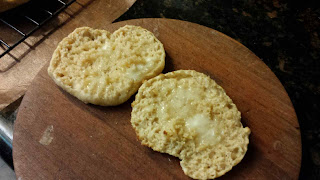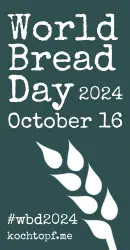December brings festive times and a festive bread. Lien, our kitchen of the month, (Notitie van Lien), challenged the Babes to create a Champagne-soaked Baba. This is a delicious and easy bread to make, so there are no excuses not to bake along!
This is similar to a batter bread, which I have made many times. I purchased small panettone papers from King Arthur Flour, and they were perfect for this bread, making 6 small babas. They don't need a special baking pan. I placed mine on a sheet pan, which worked fine, but next time I would be sure to allow sufficient space between them. I didn't want to deflate the dough by moving them, but I did notice that the bread was browned nicely on the non-touching sides.
I bought a huge bottle of champagne for the syrup. Now, I have to figure out what to do with the remainder. I also had leftover syrup, but I did use that each time I treated myself to a baba, by splitting the bun in two and drizzling the syrup over the cut sides. Pretty tasty.
Finally, I opted to cover the tops with a simple sugar glaze. I couldn't find apricot jam in the pantry, although I did locate a jar of apricot-mustard jam from Germany. Didn't think the mustard would be a favorite flavor profile on a sweet bun, but I could be wrong.
As I mentioned earlier, this is an easy bread to bake. Definitely use the syrup as it keeps the bread nice and moist. You can substitute other liquids for the champagne.
We hope you decide to bake along with us this month. Send your results to Lien by December 29 to be included in the Buddy Roundup.
Champagne Baba
(1 large
or 12 small baba’s)
sponge:
100 g water
1 tsp instant dry yeast
1 TBsp sugar
100 g bread flour
dough:
180 g bread flour
½ tsp fine salt
¼ tsp instant dry yeast
1,5 tsp vanilla sugar
3 large eggs
90 g melted butter
soaking syrup:
150 g sugar
150 g sugar
177 g water
120 g champagne (or Asti Spumante or
fruitjuice)
200 g apricot jam (or use a sugar
glaze)
Mix all the ingredients for the
sponge together in a large bowl (the one you’ll be kneading the dough in). Now
sprinkle 180 g bread flour over the sponge, so it is covered and leave to rest
for about 1 hour.
Now add the salt, ¼ tsp dry yeast,
vanilla sugar and eggs. Start to mix this. If using a stand mixer, use the
paddle attachment. When it comes together after a few minutes, add the melted
(and slightly cooled) butter and keep working it. The dough is a bit batter-like,
but be sure to get some gluten developed.
Place it in the molds. You can use a
loaf tin or a round baking form (I used a paper Panettone mold (Ø13,4 x H 9,5
cm), filled about half way up. Cover with plastic and leave to rise until 2-3
cm under the rim of the mold.
In the meantime don’t forget to
preheat the oven to 180ºC (350-360ºF).
Bake for about 45-55 minutes, until
golden brown on top. If the bread gets too dark too soon, protect the top with
a sheet of tin foil. Check the temperature in the bread with a thermometer, it
should be about 93ºC. Take out of the oven and the tin and place on a deep
dish. Poke the bread with a long wooden skewer from top to bottom. Brush the
syrup all over it, and get as much as possible inside the bread, so take your
time. Collect the syrup from the plate and keep pouring and brushing it, until
all in absorbed in the bread.
Now heat the apricot jam in a small pan and let it boil, add a little water if it is too thick. Brush or pour it over the top. You can also opt for a simple sugar glaze. This topping keeps the moisture in.
The baba is best eaten on the day that it’s baked. But if not, keep in the fridge.
Now heat the apricot jam in a small pan and let it boil, add a little water if it is too thick. Brush or pour it over the top. You can also opt for a simple sugar glaze. This topping keeps the moisture in.
The baba is best eaten on the day that it’s baked. But if not, keep in the fridge.
- Blog from OUR Kitchen – Elizabeth
- A Messy Kitchen – Kelly
- Karen’s Kitchen Stories – Karen
- Notitie Van Lien – Lien
- My Diverse Kitchen - Aparna
- Bread Experience - Cathy
- Thyme for Cooking - Katie
- My Kitchen in Half Cups - Tanna
- Bake My Day - Karen
- Feeding My Enthusiasms - Elle















